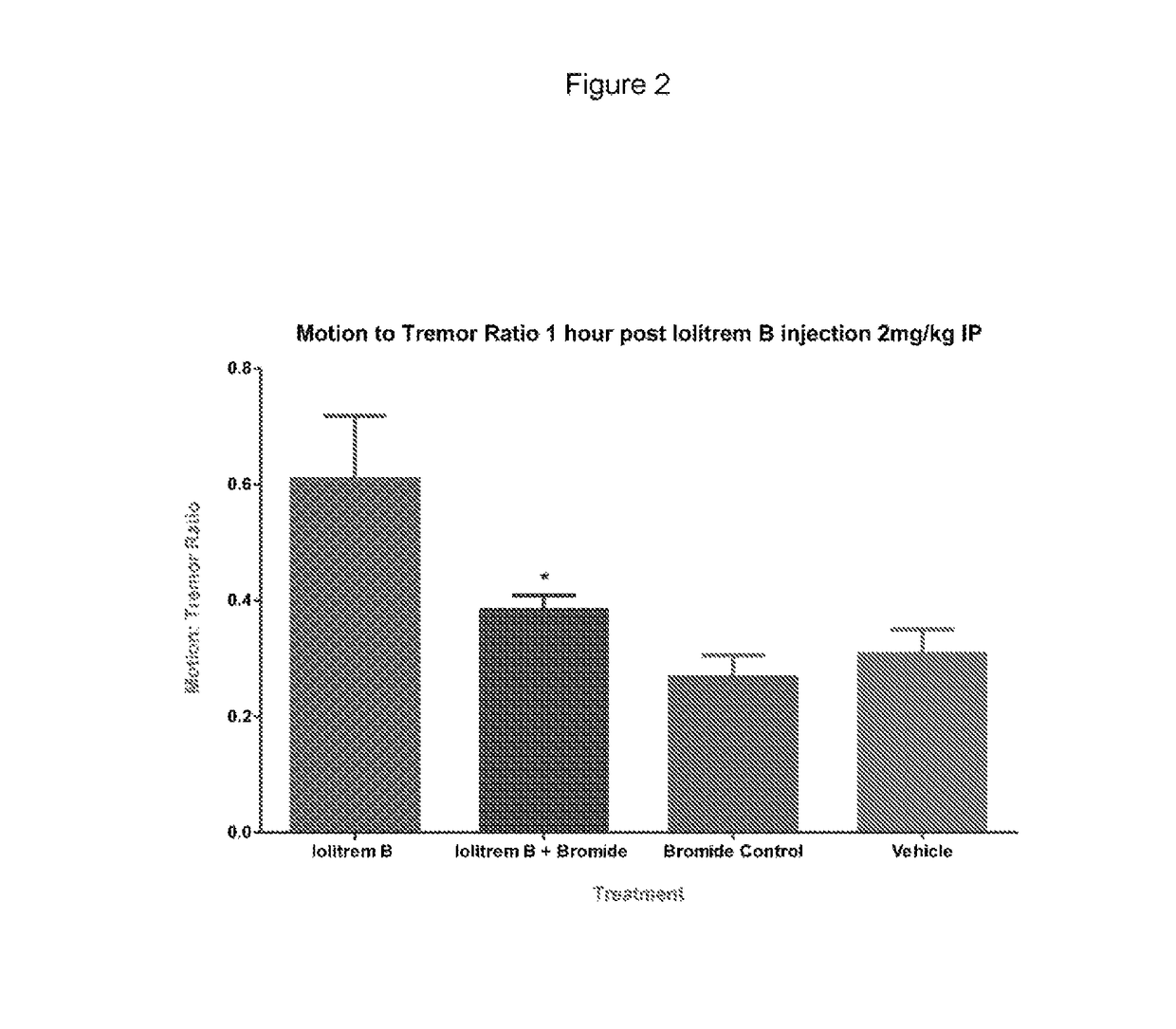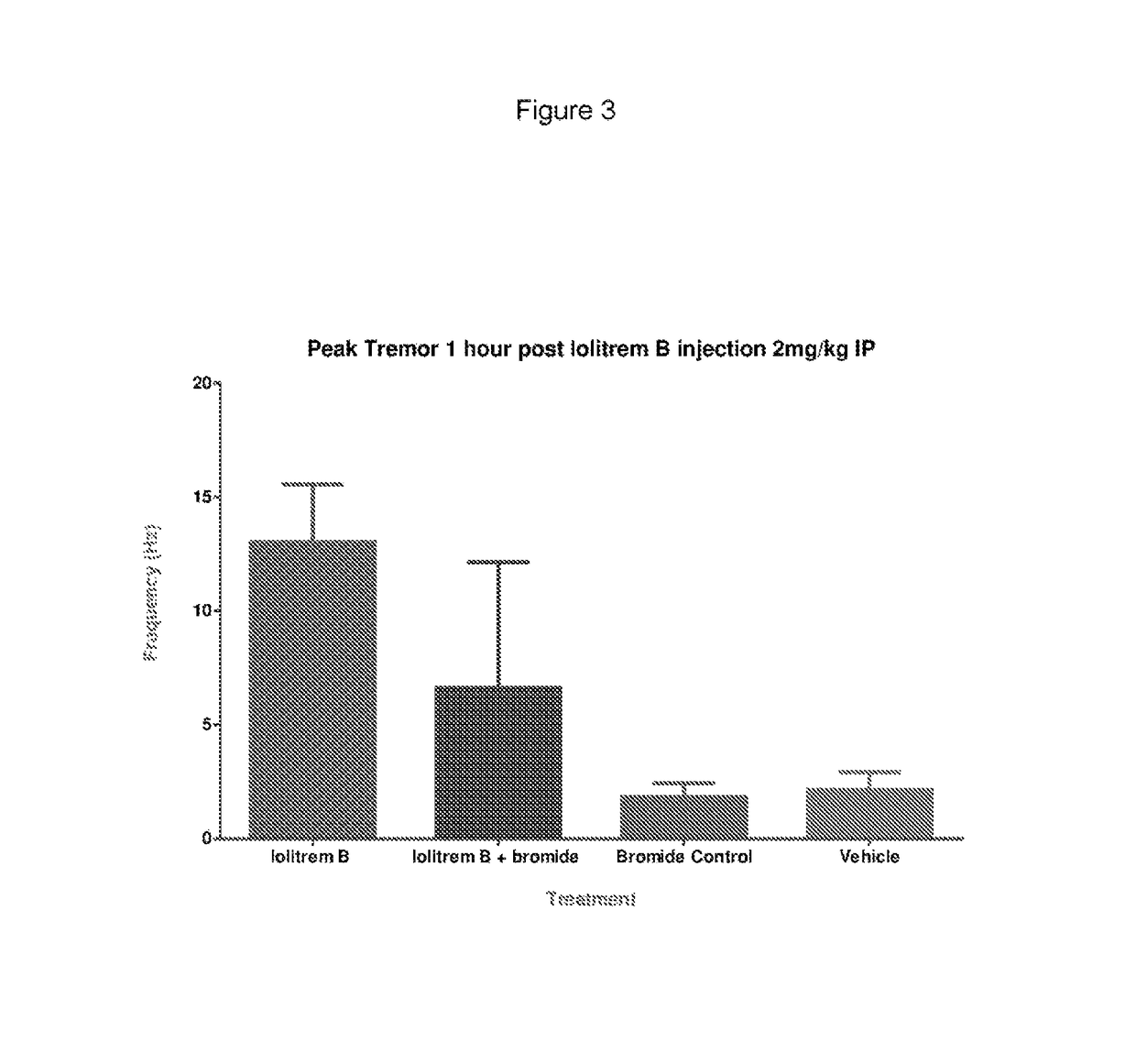Prevention and treatment of toxicosis
a technology of toxicosis and treatment, applied in the direction of anti-noxious agents, pharmaceutical delivery mechanisms, aluminium/calcium/magnesium active ingredients, etc., can solve the problems of increased severity of ill-coordination of movement, initial or continued sternal recumbency, and neuromuscular dysfunction, so as to prevent the animal from developing symptoms of phalaris toxicity, prevent the symptoms of lolitrem b toxicity, and prevent the effect of phalaris toxicity
- Summary
- Abstract
- Description
- Claims
- Application Information
AI Technical Summary
Benefits of technology
Problems solved by technology
Method used
Image
Examples
example 1
[0103]Lolitrem B was tested in mice to establish this as a suitable model for perennial ryegrass toxicosis and lolitrem B intoxication in grazing animals. Lolitrem B (in a dose of 2 mg / kg) administered intraperitoneally (IP) produced a decrease in movement and a distinctive tremor spike in the range of 10-19 Hz. These signs are consistent with clinical signs seen in grazing animals (See FIG. 1).
example 2
[0104]Bromide Alleviates / Prevents Clinical Signs of Lolitrem B Intoxication in a Rodent Model of PRGT.
[0105]To investigate the potential of bromide as a therapeutic agent for perennial ryegrass toxicosis and lolitrem B intoxication in grazing animals. Mice were administered 2500 ppm KBr in their drinking water for 7 days prior to injection with lolitrem B (2 mg / kg IP). Mice demonstrated reduced tremor to movement ratio and reduced peak tremor frequency at one hour post injection. Animals tested in a novel arena test at 3.5 hours post lolitrem B injection (2 mg / kg IP) demonstrated increased movement and reduce time freezing. This provides strong evidence that bromide can alleviate or prevent clinical signs of perennial ryegrass toxicosis and lolitrem B intoxication (See FIGS. 2 to 5).
example 3
[0106]Determination of Pharmacokinetics of Bromide in Sheep after Single Intravenous (IV) and Oral (PO) Doses
[0107]Sixteen Merino sheep were randomly assigned to two treatment groups. The intravenous (IV) group were given 120 mg / kg bromide, as sodium bromide. The per os (PO-oral) group were given 120 mg / kg bromide, as potassium bromide. Serum bromide concentrations were determined by colorimetric spectrophotometry.
[0108]Animals:
[0109]Sixteen sheep, weighing between 49.5 kg and 67 kg and with an average body condition score of >2 were randomly divided into equal number (IV and PO treatment groups). Animals were placed in individual feeding pens and were fed twice daily on a ration of oats and lupins as well as ad libitum hay and water. Estimated chloride content for oats and lupins was 0.11% and 0.4% respectively.
[0110]Indwelling intravenous cannulas (Braun, Certo Splittocan 335, 16 gauge, 32 cm) were placed into the left jugular vein and secured with 2 / 0 polypropylene suture. A 25 c...
PUM
 Login to View More
Login to View More Abstract
Description
Claims
Application Information
 Login to View More
Login to View More - R&D
- Intellectual Property
- Life Sciences
- Materials
- Tech Scout
- Unparalleled Data Quality
- Higher Quality Content
- 60% Fewer Hallucinations
Browse by: Latest US Patents, China's latest patents, Technical Efficacy Thesaurus, Application Domain, Technology Topic, Popular Technical Reports.
© 2025 PatSnap. All rights reserved.Legal|Privacy policy|Modern Slavery Act Transparency Statement|Sitemap|About US| Contact US: help@patsnap.com



